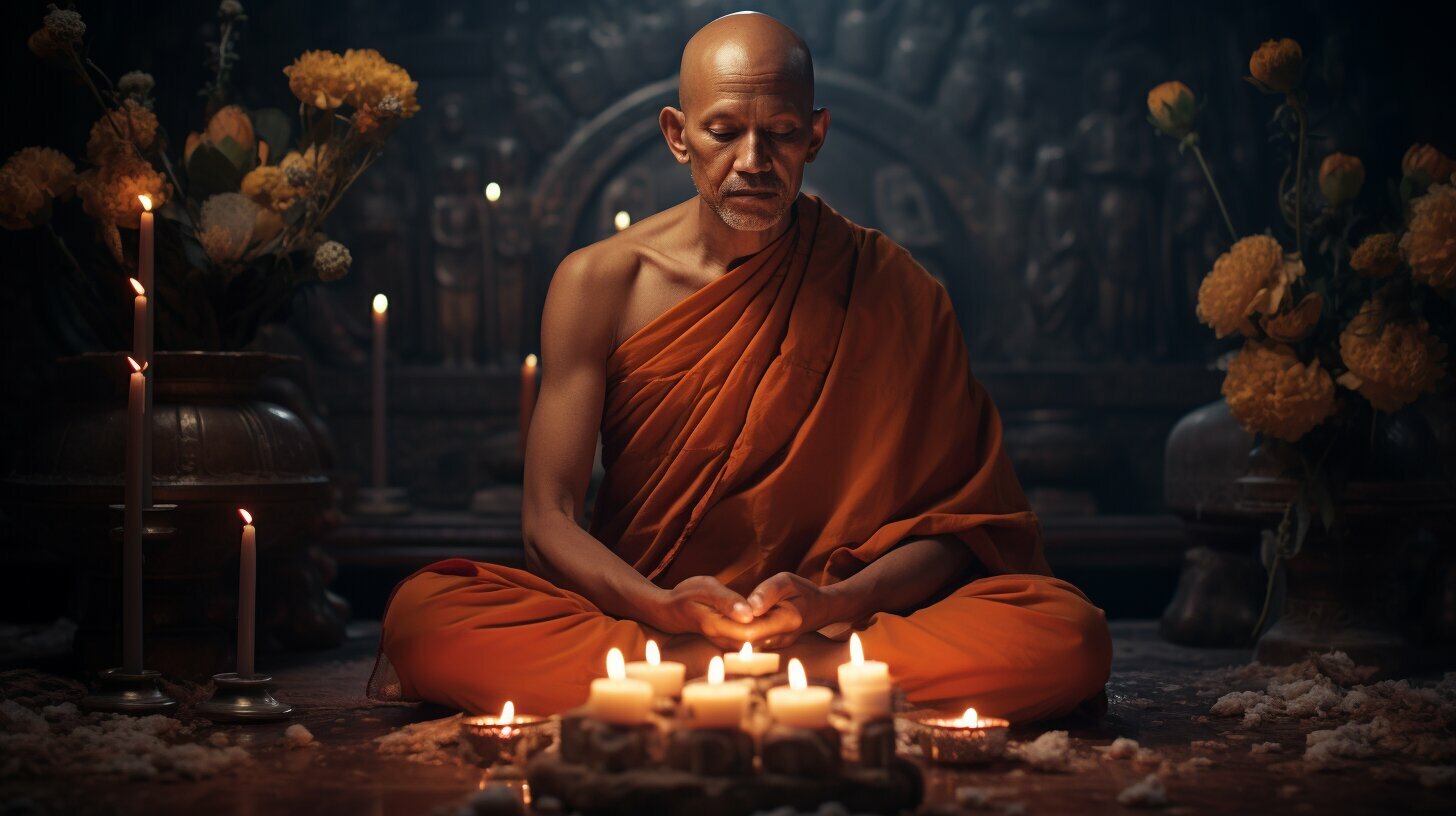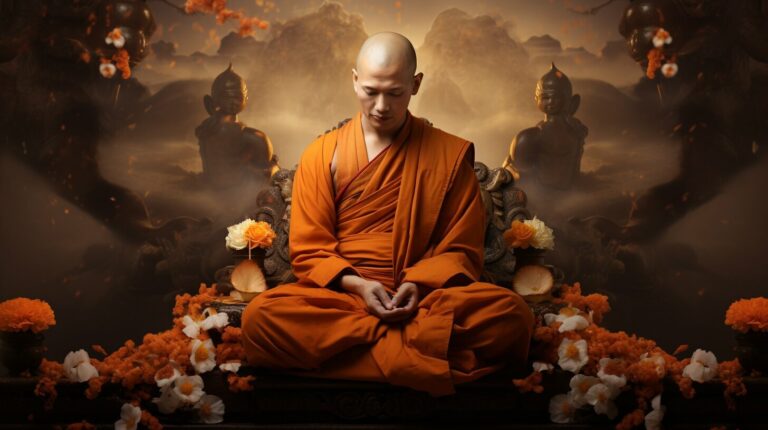Unraveling the Mystery: Why Do Monks Wear Orange?
Monks wearing orange robes have long intrigued and fascinated people, prompting the question: why do they choose this particular color? The significance and symbolism of monks’ orange attire go beyond mere fashion choices. Let’s explore the reasons behind this ancient tradition.
Key Takeaways:
- Monks wear orange robes for cultural, religious, and symbolic reasons.
- The color orange represents simplicity, detachment from materialism, and a connection to the Earth.
- In India, red earth soil is used to dye robes, signifying existential understanding and a bond with the planet.
- In Southeast Asia, orange became the chosen color because it was the dye available during the tradition’s inception.
- Shaving their heads further signifies simplicity and detachment for monks.
The Cultural and Religious Meaning of Monks’ Orange Clothing
The orange clothing worn by monks holds deep cultural and religious significance, dating back centuries in various traditions. In India, monks color their robes with a distinctive shade of orange, which is achieved by dyeing the clothes with red earth soil. This practice stems from the ancient tradition of meditating near anthills, which are built with soil mixed with termite saliva. By wearing orange robes, monks symbolize their existential understanding and connection to the planet, emphasizing their desire to stay grounded and connected to the Earth.
In Southeast Asia, particularly in Buddhist traditions, the wearing of orange robes by monks also carries significant meaning. Orange was the dye that was readily available at the time the tradition began, and it has since become associated with simplicity and detachment from materialism. The color orange symbolizes the renunciation of worldly desires and the monk’s commitment to leading a life of simplicity and selflessness. By donning the orange robes, monks visually represent their dedication to the pursuit of spiritual enlightenment and their detachment from material possessions.
In addition to the color of their robes, monks also shave their heads, further emphasizing the principles of simplicity and detachment. The shaved heads signify the renunciation of vanity and the shedding of attachment to physical appearance. By removing their hair, monks embrace a minimalist lifestyle and embody the teachings of impermanence and non-attachment.
The Symbolism of Monks’ Orange Attire
Monks’ orange attire carries profound symbolism that reflects their commitment to spiritual practice and the pursuit of enlightenment. The vibrant orange color itself represents the qualities of transformation, energy, and enthusiasm. It is believed to awaken the mind and foster inner strength within the individual wearing it. The bright hue serves as a visual reminder not only to the monks themselves but also to those who encounter them of the spiritual path and the potential for personal growth and transformation.
The choice to wear orange robes goes beyond mere tradition or fashion. It is a conscious decision made by monks to cultivate humility, simplicity, and detachment from worldly attachments. The significance of monks’ orange clothing can be seen in the way it acts as a powerful symbol of the monk’s commitment to a life of selflessness, spiritual growth, and liberation from suffering.
| Key Points: | References: |
|---|---|
| The orange clothing worn by monks holds deep cultural and religious significance. | [1] |
| In India, monks color their robes with red earth soil, symbolizing their connection to the Earth. | [2] |
| In Southeast Asia, orange robes represent simplicity and detachment from materialism. | [3] |
| Monks shave their heads to further signify simplicity and detachment. | [4] |
| Monks’ orange attire symbolizes transformation, energy, and enthusiasm. | [5] |
“The orange robe represents our commitment to a life of simplicity and selflessness. It serves as a reminder of the importance of letting go of attachments and cultivating inner peace.” – Venerable Thich Nhat Hanh
- The orange clothing worn by monks is deeply rooted in cultural and religious traditions.
- In India, monks color their robes with red earth soil to signify their connection to the Earth.
- In Southeast Asia, orange robes represent simplicity and detachment from materialism.
- Monks shave their heads as a symbol of simplicity and non-attachment.
By understanding the cultural and religious meanings behind monks’ orange clothing, we gain insights into their commitment to a life of spiritual practice and the pursuit of enlightenment. The vivid orange color, the use of red earth soil, and the act of shaving their heads all serve as visual representations of the values that monks uphold. These robes not only hold deep symbolism for the monks themselves but also provide inspiration and reminders for those who encounter them on their own spiritual journeys.
References:
[1] Embracing the Orange: Symbolism of Monastic Robes – Tricycle: The Buddhist Review
[2] The Significance of the Color Orange in Buddhism – Learn Religions
[3] The Significance of the Color Orange in Buddhist Monastic Robes – ThoughtCo
[4] Buddhist Monk – The Nam Hai Life
[5] Understanding the Significance of Buddhist Robes – Discover Nikkei
The Symbolism of Monks’ Orange Attire
The orange robes worn by monks carry symbolic meaning, reflecting their spiritual journey and commitment to a higher purpose. In both India and Southeast Asia, this vibrant color holds deep significance in the monastic tradition.
In India, monks color their robes with red earth soil, which represents their existential understanding and connection to the planet. This practice is rooted in the tradition of meditating near anthills, which are built with soil mixed with termite saliva. By wearing orange robes colored with earth, monks aim to stay grounded and connected to the Earth’s energy, symbolizing their pursuit of stability and balance.
Meanwhile, in Southeast Asia, the tradition of wearing orange robes began simply because orange dye was readily available at the time. However, over time, the color took on deeper symbolism. Orange is associated with simplicity and detachment from materialism, reflecting the monks’ commitment to leading a life free from attachment to worldly possessions. The choice to shave their heads further emphasizes the values of simplicity and detachment.
The Spiritual Significance of Orange Robes in Monastic Life
For monks, the act of wearing orange robes goes beyond mere clothing. It signifies a renunciation of material desires and a dedication to spiritual growth. The color itself is believed to have a transformative and energizing effect, helping monks align their thoughts and actions with their spiritual path.
“Wearing orange robes reminds me of my purpose – to seek enlightenment and serve others. It’s a constant reminder to let go of attachments and focus on inner development,” says Ven. Dharmapala, a Buddhist monk.
The bright orange hue is thought to represent the flame of enlightenment, illuminating the path towards wisdom and awakening. Donning these robes serves as a visual representation of the monk’s commitment to the pursuit of truth, compassion, and self-discovery.
| Symbolism of Monks’ Orange Attire: |
|---|
| Connection to the Earth |
| Simplicity and detachment from materialism |
| Renunciation of worldly desires |
| Alignment with spiritual path and enlightenment |
By understanding the symbolism behind the orange robes worn by monks, we gain insight into the profound meaning behind their choice of attire. These vibrant robes not only serve as a visual representation of their spiritual journey but also inspire others to reflect on their own values and priorities. The monks’ commitment to simplicity, detachment, and inner growth is a timeless reminder of the importance of seeking a higher purpose in our own lives.
The Connection to Earth and Simplicity
Monks embrace the color orange as a representation of their commitment to simplicity, detachment, and their connection to the Earth. In India, where the practice of wearing orange robes originated, the color is derived from red earth soil. This signifies the monks’ existential understanding and deep connection to the planet. The tradition stems from the practice of meditating near anthills, which are built with soil mixed with termite saliva. By wearing orange robes, the monks aim to stay connected to the Earth and maintain a sense of stability within their bodies.
In Southeast Asia, where Buddhist monks also wear orange robes, the color choice has historical significance. During the time when the tradition began, orange dye was readily available. The color orange, in this context, symbolizes simplicity and detachment from materialism. By adorning themselves in orange robes, the monks embrace a life of minimalism and strive to detach themselves from worldly possessions.
To further signify their commitment to simplicity and detachment, monks in both India and Southeast Asia shave their heads. This act serves as a physical representation of letting go of attachment to appearance and embracing a life of inner focus and tranquility. By adopting this outward symbol, they strive to cultivate a sense of peace and detachment from the distractions of society.
| Reasons for Wearing Orange Robes | Symbolism |
|---|---|
| To stay connected to the Earth | Commitment to simplicity and detachment |
| Representation of existential understanding | Embrace of inner focus and tranquility |
| Cultural and historical significance | Detachment from materialism |
By wearing orange robes and shaving their heads, monks in India and Southeast Asia not only signal their commitment to a simpler way of life but also inspire others to contemplate the importance of detachment and connection to the Earth. The color orange serves as a powerful symbol of their spiritual journey, reminding us all of the beauty that lies in simplicity and the importance of finding harmony within ourselves and with the world around us.
The Origins of Orange Robes in India and Southeast Asia
The tradition of wearing orange robes among monks originated in both India and Southeast Asia, with unique cultural and religious influences shaping this practice. In India, the significance of orange robes for monks can be traced back to the monks’ deep connection to the Earth. The monks color their clothes with red earth soil, a powerful symbol of their existential understanding and bond with the planet. This tradition is rooted in the monks’ practice of meditating near anthills, which are built with soil mixed with termite saliva. By wearing orange robes, the monks seek to stay grounded and connected to the Earth, reminding themselves of the importance of stability and balance.
In Southeast Asia, the choice of orange robes for Buddhist monks was more practical. When the tradition began, orange was the dye readily available, leading to its adoption as the color of choice. However, despite its practical origins, the color orange holds deep symbolism for these monks. It represents simplicity and detachment from materialism, two principles that are fundamental to the monastic way of life. By donning orange robes, the monks symbolize their commitment to lead a simple, minimalist existence and their renunciation of worldly possessions.
In addition to wearing orange robes, monks in both India and Southeast Asia also shave their heads. This practice further emphasizes the principles of simplicity and detachment, signifying the renunciation of vanity and attachment to physical appearance. The shaved head represents a shedding of ego and a desire to transcend superficiality in favor of a deeper spiritual connection.
Overall, the tradition of monks wearing orange robes in India and Southeast Asia holds deep cultural and religious significance. The color orange serves as a visual representation of the monks’ commitment to simplicity, detachment, and a profound connection to the Earth. Through their attire and appearance, these monks convey their dedication to a higher spiritual path, reminding us all of the importance of grounding ourselves, simplifying our lives, and seeking inner peace.
Conclusion
The choice of orange robes by monks is deeply rooted in tradition and symbolism, representing their commitment to simplicity, spirituality, and detachment from material possessions. Monks in India and Southeast Asia wear orange robes for various reasons. In India, the monks color their clothes with red earth soil to signify their existential understanding and connection to the planet. This practice stems from the tradition of meditating near anthills, which are built with soil mixed with termite saliva. The monks aim to stay connected to the Earth and keep their bodies in a state of stability.
In Southeast Asia, Buddhist monks wear orange robes because it was the dye available at the time the tradition began. The color symbolizes simplicity and detachment from materialism. Additionally, monks shave their heads to further signify simplicity and detachment. By embracing these practices, monks seek to overcome attachment to external possessions and focus on their spiritual growth.
The adoption of orange robes by monks in both India and Southeast Asia showcases the timeless significance of this tradition. The color orange holds a spiritual and philosophical meaning that resonates with the monks’ way of life. It represents their commitment to simplicity, humility, and their pursuit of enlightenment. Through their choice of attire, monks communicate their devotion to the path of spirituality, reminding themselves and others of the importance of living a life free from material distractions.
In conclusion, the symbolism behind monks’ orange attire goes beyond mere aesthetics. It is a powerful visual representation of the monks’ dedication to their spiritual journey and the values they hold dear. The wearing of orange robes allows monks to embody their commitment to simplicity, spirituality, and detachment from material possessions, reminding us all of the profound wisdom that can be found in embracing a simpler way of life.
FAQ
Why do monks wear orange?
Monks wear orange robes for various reasons. In India, the monks color their clothes with red earth soil to signify their existential understanding and connection to the planet. In Southeast Asia, Buddhist monks wear orange robes because it was the dye available at the time the tradition began. The color symbolizes simplicity and detachment from materialism.
What is the significance of orange robes for monks?
The orange robes worn by monks hold cultural and religious significance. They represent the monks’ pursuit of simplicity, detachment from material possessions, and their connection to the Earth. The color orange also embodies spiritual and philosophical concepts that are central to monastic life.
Why do monks shave their heads?
Monks shave their heads as a further symbol of simplicity and detachment. By removing their hair, monks eliminate any attachment to personal appearance and vanity. Shaving the head also represents a commitment to a life dedicated to spiritual practice and renunciation of worldly desires.
What is the historical origin of monks wearing orange robes?
The tradition of monks wearing orange robes originated in India and Southeast Asia. In India, the tradition stems from the practice of meditating near anthills, which are built with soil mixed with termite saliva. In Southeast Asia, orange dye was readily available at the time the tradition began, leading to its adoption as the color for monastic attire.
What is the cultural and religious meaning behind monks’ orange clothing?
Monks’ orange clothing holds cultural and religious significance. It represents their commitment to simplicity, detachment, and spiritual practice. The orange color is associated with renunciation of material possessions and a focus on inner growth and enlightenment.






